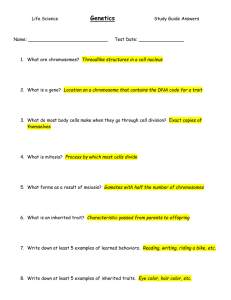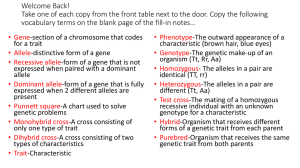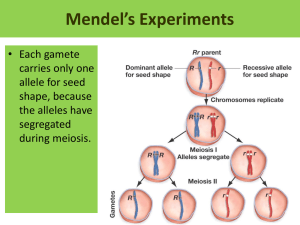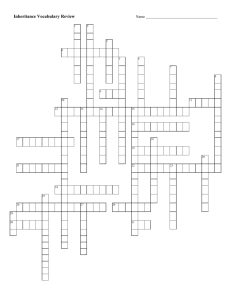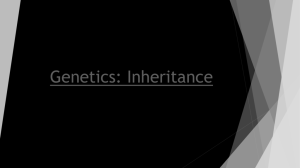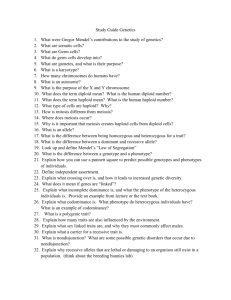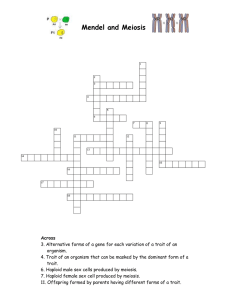Directions: Name: _____________________ questions. The exam will cover topics from 2
advertisement
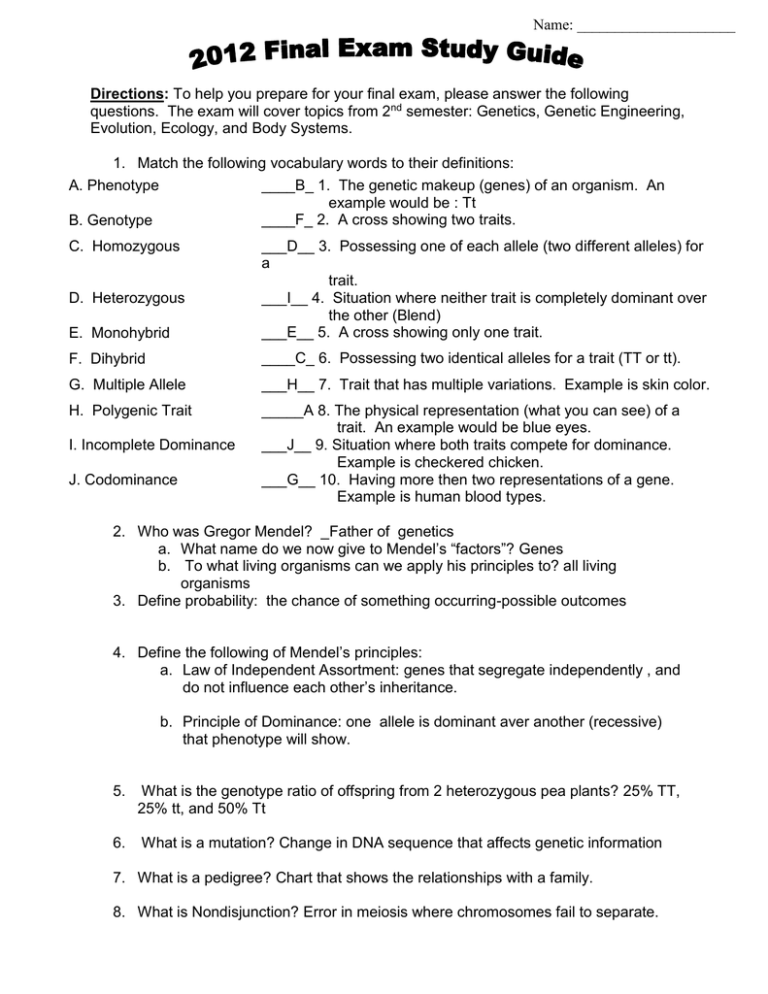
Name: _____________________ Directions: To help you prepare for your final exam, please answer the following questions. The exam will cover topics from 2nd semester: Genetics, Genetic Engineering, Evolution, Ecology, and Body Systems. 1. Match the following vocabulary words to their definitions: ____B_ 1. The genetic makeup (genes) of an organism. An A. Phenotype example would be : Tt ____F_ 2. A cross showing two traits. B. Genotype E. Monohybrid ___D__ 3. Possessing one of each allele (two different alleles) for a trait. ___I__ 4. Situation where neither trait is completely dominant over the other (Blend) ___E__ 5. A cross showing only one trait. F. Dihybrid ____C_ 6. Possessing two identical alleles for a trait (TT or tt). G. Multiple Allele ___H__ 7. Trait that has multiple variations. Example is skin color. H. Polygenic Trait _____A 8. The physical representation (what you can see) of a trait. An example would be blue eyes. ___J__ 9. Situation where both traits compete for dominance. Example is checkered chicken. ___G__ 10. Having more then two representations of a gene. Example is human blood types. C. Homozygous D. Heterozygous I. Incomplete Dominance J. Codominance 2. Who was Gregor Mendel? _Father of genetics a. What name do we now give to Mendel’s “factors”? Genes b. To what living organisms can we apply his principles to? all living organisms 3. Define probability: the chance of something occurring-possible outcomes 4. Define the following of Mendel’s principles: a. Law of Independent Assortment: genes that segregate independently , and do not influence each other’s inheritance. b. Principle of Dominance: one allele is dominant aver another (recessive) that phenotype will show. 5. What is the genotype ratio of offspring from 2 heterozygous pea plants? 25% TT, 25% tt, and 50% Tt 6. What is a mutation? Change in DNA sequence that affects genetic information 7. What is a pedigree? Chart that shows the relationships with a family. 8. What is Nondisjunction? Error in meiosis where chromosomes fail to separate. 9. Compare and contrast the processes of mitosis and meiosis. Mitosis Meiosis Produces two genetically identical diploid alleles 10. What is crossing over? a. When in meiosis would this occur? 11. What is the ultimate source of genetic variability? 12. What is the purpose of selective breeding? Inbreeding? Artificial breeding? 13. How many chromosomes does the normal human have? _______ a. What is the our diploid number? _______ b. What is the our haploid number? _______ c. What would our skin cells be? (diploid/haploid) d. What would our gametes be? (diploid/haploid) e. How many of our chromosomes are sex chromosomes? ______ i. What would my sex chromosomes be if I were female? ______ ii. If I were male? ________ 14. What is the purpose of a karyotype? a. What are the three things that karyotype shows? 15. In pedigrees, males are drawn as a ______ and females are drawn as a _______. 16. Where are most sex-linked (X-linked) traits located? ___________________. a. Who would you acquire a sex-linked disorder from? (mother/father) 17. What is a transgenic organism? 18. What is the purpose of recombinant DNA? 19. What is genetic engineering? 20. What types of cells are required for cloning? 21. If a mom as blood type ii (OO) and dad has blood type IAIB (AB), what are the possible genotypes and phenotypes of their children? 22. Match the following disease or disorders to their definitions. Genetic Disorder Caused by: Recessive, Symptoms Dominant, Codominant, Nondisjuction or sexlinked? Huntington Down Syndrome Turner’s Syndrome Klinefelter’s Syndrome Hemophilia Color-Blindness 23. What are the two main sources of genetic variation? 24. Who was Charles Darwin? a. Where did most of Darwin’s observations occur? _______________________ b. What adaptation did he study amongst the finches? _____________________ c. What is the name of Darwin’s theory? _______________________________ aka survival of the _________________ . d. His theory acts on genotypes or phenotypes?_______________________ e. What was his book called? ____________________________ 25. Define and give an example of how each of the following terms: a. homologous structures: - example: b. analogous structures: - example: c. vestigial organs: - example: 26. What is genetic equilibrium? 27. What is a biosphere? 28. What are the levels of organization? 29. What is a gene pool? 30. What are the three types of selection and describe them. 31. Define speciation. a. Speciation requires reproductive isolation. How do you obtain reproductive isolation (3 ways) and define each one of them. 1. _____________________________________________________ 2. _____________________________________________________ 3. _____________________________________________________ 32. What is the difference between a food chain and a food web? 33. Complete the chart below: Source of energy Example Autotroph Chemotroph Heterotroph 34. List the 5 main types of heterotrophs AND how they obtain their energy. a. ____________________________________________________________ b. ____________________________________________________________ c. ____________________________________________________________ d. ____________________________________________________________ e. ____________________________________________________________ 35. What is a niche? : 36. What is a trophic level? 37. Name, define, and give an example for the 3 main types of symbiotic relationships. Symbiotic Relationship Definition 38. What happens to the energy as it goes to each trophic level? 39. What is ecology? Example 40. What is climate? 41. Complete the Venn diagram for primary and secondary succession 42. List each biome and give one main characteristics of each. 43. What are the three types of pyramids? 44. Can energy be recycled? 45. Name 2 factors that might make a population smaller. a. ____________________________________________________________ b. ____________________________________________________________ 46. What is the original source of all energy? 47. What types of organisms do not require sunlight? 48. Define immigration. 49. Define emigration. 50. Define limiting factor. 51. What is the difference between density-independent and density-dependent factors. a. Give one example for each. 52. Define demography. 53. What is homeostasis? 54. In fish, what is the purpose of a swim bladder? 55. What are some of the adaptations of amphibians that allow them to live on land? 56. Describe the process of digestion. 57. What is the function of your kidneys. 58. What is the definition of the following words: a. b. c. d. Dorsal Ventral Radial symmetry Bilateral symmetry 59. Where can reptiles NOT live? 60. What characteristics are special to birds of prey? 61. How do reptiles breathe? 62. What is the difference between a reptile, amphibian, and bird eggs? 63. What is a stimulus and reaction? 64. What is significant about an insect’s compound eye? 65. What organism is the simplest one with symmetry? 66. What is the difference between an invertebrate and a vertebrate? 67. What are the basic characteristics of mammals? 68. What are the differences between: a. Marsupials b. Monotremes c. Placental mammals 69. Complete the following table (be able to describe what each organ does): Body System Function Major Organs Excretory Digestive 70. Where does chemical digestion begin? 71. What is the purpose of food?
